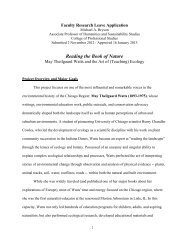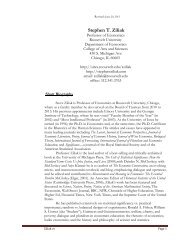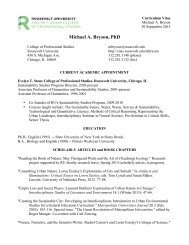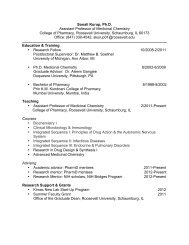Social Insurance and Public Assistance
public-assistance-welfare-reform-colonial-times-to-the-present-ziliak ...
public-assistance-welfare-reform-colonial-times-to-the-present-ziliak ...
Create successful ePaper yourself
Turn your PDF publications into a flip-book with our unique Google optimized e-Paper software.
782 Series Bf484–496 Bf SOCIAL INSURANCE AND PUBLIC ASSISTANCE<br />
TABLE Bf484–496 Unemployment <strong>Insurance</strong> – coverage, benefits, <strong>and</strong> financing: 1938–1997 Continued<br />
Average Average Average Taxable<br />
Average weekly benefit actual actual wages paid in<br />
monthly Average Average Average as percentage duration Claimants duration of Total covered Net reserves,<br />
covered weekly insured First weekly initial weekly benefit of average of benefit exhausting benefits for Total benefits contributions employment balance as of<br />
employment unemployment payments claims amount weekly wage payments benefits exhaustees paid collected during year end of year<br />
Bf484 Bf485 Bf486 Bf487 Bf488 Bf489 Bf490 Bf491 Bf492 Bf493 Bf494 Bf495 Bf496<br />
Thous<strong>and</strong> Thous<strong>and</strong> Thous<strong>and</strong> Thous<strong>and</strong><br />
Year Number Number Number Number Dollars Percent Weeks Number Weeks dollars dollars dollars dollars<br />
1980 71,258,455 3,355,747 9,992,123 479,769 99.66 36.6 14.9 3,071,943 22.7 13,768,135 11,414,649 458,643,511 6,591,827<br />
1981 71,965,970 3,044,857 9,407,372 450,846 106.61 35.9 14.4 2,989,177 23.0 13,221,592 11,624,545 478,414,824 5,745,115<br />
1982 70,331,861 4,058,646 11,648,448 579,252 119.34 37.7 15.9 4,174,709 23.2 20,649,840 12,206,070 477,471,932 2,644,584<br />
1983 70,817,863 3,394,666 8,907,190 441,653 123.59 37.2 17.5 4,179,622 23.4 17,755,392 14,548,669 532,288,687 5,803,331<br />
1984 75,204,621 2,474,809 7,742,547 371,773 123.47 35.5 14.4 2,606,145 22.8 12,598,229 18,757,690 586,020,262 2,204,797<br />
1985 77,467,012 2,616,958 8,372,070 390,294 128.14 35.3 14.2 2,572,059 22.7 14,124,342 19,296,983 611,969,897 10,069,416<br />
1986 79,093,152 2,642,644 8,360,752 376,227 135.65 35.8 14.5 2,687,723 22.9 15,402,735 18,111,266 638,038,517 15,402,260<br />
1987 81,352,396 2,300,399 7,203,357 326,153 140.55 35.5 14.6 2,408,471 22.7 13,617,007 17,576,976 667,498,815 23,174,690<br />
1988 83,984,776 2,080,582 6,860,662 312,882 144.97 34.9 13.7 1,979,285 22.7 12,579,703 17,720,628 705,002,395 31,103,671<br />
1989 86,164,595 2,157,666 7,368,766 328,819 151.73 35.4 13.2 1,940,390 22.9 13,641,569 16,451,876 738,265,107 36,870,882<br />
1990 87,008,189 2,521,564 8,628,557 387,001 161.56 36.0 13.4 2,323,255 23.1 17,320,777 15,221,274 759,670,530 37,937,017<br />
1991 84,905,782 3,341,935 10,074,550 447,593 169.88 36.4 15.4 3,472,019 23.2 24,582,501 14,510,670 751,666,268 30,488,785<br />
1992 85,098,137 3,245,191 9,243,338 407,344 173.64 35.4 16.2 3,838,011 23.3 23,956,510 16,972,655 776,502,595 25,846,579<br />
1993 86,850,536 2,751,441 7,884,326 342,309 179.62 36.0 15.9 3,203,897 23.4 20,687,678 19,831,045 807,165,885 28,001,956<br />
1994 89,690,770 2,669,872 7,959,281 342,730 182.16 35.7 15.5 2,977,468 23.2 20,433,832 21,802,069 856,255,509 31,343,551<br />
1995 92,328,088 2,571,951 8,035,229 357,041 187.29 35.5 14.7 2,661,773 23.1 20,122,189 21,970,828 889,901,028 35,403,296<br />
1996 94,685,734 2,595,585 7,989,615 351,361 189.45 34.5 14.9 2,738,963 23.2 20,634,904 21,577,968 923,895,199 38,631,922<br />
1997 97,837,884 2,322,573 7,325,279 321,511 192.76 33.5 14.6 2,484,911 23.0 18,605,353 21,247,040 970,110,253 43,833,157<br />
Sources<br />
All series except series Bf487. Unemployment <strong>Insurance</strong> Financial Data H<strong>and</strong>book number 394 from the<br />
Information Technology Support Center (ITSC) in Maryl<strong>and</strong>.<br />
Series Bf487. Through 1966, data were collected by the Bureau of the Census from monthly issues of<br />
the U.S. Manpower Administration’s Unemployment Statistics. Beginning in 1967, data are from evidence<br />
posted February 24, 2000, on the U.S. Department of Labor, Employment Training Administration<br />
Internet site.<br />
Documentation<br />
ITSC is a collaboration of state employment security agencies, the Department of Labor (DOL), <strong>and</strong><br />
private sector partners. Most of these data were compiled from monthly <strong>and</strong> quarterly statistical <strong>and</strong><br />
accounting reports submitted by the State Employment Security agencies to the U.S. Employment <strong>and</strong><br />
Training Administration of the U.S. Department of Labor. Revised data <strong>and</strong> corrections have been<br />
incorporated into this edition to the extent possible. Data contained in this h<strong>and</strong>book may not be<br />
identical with state records.<br />
The <strong>Social</strong> Security Act of 1935 established Unemployment <strong>Insurance</strong> (UI) as a federally m<strong>and</strong>ated<br />
program run by the states. The states collect payroll taxes from employers to fund the system. After<br />
the <strong>Social</strong> Security Act passed, the states had to pass enabling legislation <strong>and</strong> then wait two years to<br />
accumulate enough reserves to begin paying benefits. Because Wisconsin had passed an unemployment<br />
insurance act prior to 1935, it was the first state to pay benefits. By 1938, roughly 75 percent<br />
of payrolls were covered by unemployment insurance. The percentage rose to a peak of 98 percent in<br />
1979 <strong>and</strong> fell back to about 92.4 percent in 1994.<br />
To fund the system, employers pay taxes on employee earnings up to a specific maximum per employee<br />
in each state. Part of the taxes (0.4 percent of taxable wages in 1970) is remitted to the federal<br />
government, which in turn provides grants to the states for the cost of administering unemployment<br />
insurance <strong>and</strong> employment services. The payroll contribution rates for individual employers vary to<br />
some extent in response to the unemployment experience of workers in the employer’s operation.<br />
Reimbursable coverage has been excluded from series Bf484 <strong>and</strong> Bf493–495. However, the claims<br />
resulting from reimbursable coverage have not been excluded from series Bf485–486 <strong>and</strong> Bf488–492.<br />
In June 1962, employees engaged in the agricultural aspects of the sugar cane industry who were<br />
previously covered under a special unemployment insurance law were brought under the Puerto Rico<br />
Employment Security Act of 1957.<br />
Series Bf484. Average monthly covered employment represents the twelve-month average of the covered<br />
employees reported to states by each employer for 1938–1944 for the last payroll period in the<br />
month. For 1945–1962, data represent the twelve-month average for the payroll period ending nearest<br />
the fifteenth day of the month. After 1963, data represent the twelve-month average for the payroll<br />
period including the twelfth day of the month. Covered employment represents employment in industrial<br />
<strong>and</strong> commercial establishments of eight or more for the period 1941–1955 <strong>and</strong> four or more<br />
for 1956 to 1970. In some states, the covered employment also represents employment in smaller<br />
establishments <strong>and</strong> for additional groups of workers, such as state <strong>and</strong> local employees or seamen.<br />
Although the federal law requires only employers to pay taxes, some states require some workers to<br />
contribute as well.<br />
Series Bf484–485. Beginning in 1964, the series on the average number of weekly insured employment,<br />
series Bf485, includes workers in the sugar cane industry, while series Bf484 excludes them.<br />
Series Bf487. Calculated as an average for the year of the number of initial claims for unemployment<br />
insurance filed each week. An initial claim is “any notice of unemployment filed (1) to request a determination<br />
of entitlement to <strong>and</strong> eligibility for compensation or (2) to begin a second or subsequent<br />
period of eligibility within a benefit year or period of eligibility.”









